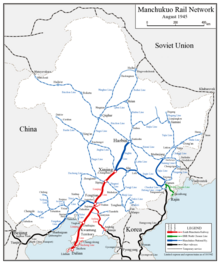Peking–Mukden Railway
[1] With the length of about 9 km, this railway was completed in November 1881 as a tramway to help the coals in Kaiping Mines move to Tangshan to meet the demands of Imperial Chinese Navy and China Merchants Steam Navigation Company.
[2] After examining the quality of the equipments in person, Li Hongzhang said that "the railway from Tianjin to Tangshan is steady, and the bridges and stations are all built in compliances with technical requirements".
[9]At the beginning of 1890, Zongli Yamen suggested railway construction in Northeast China to resist Japan's lust on Korean Peninsula.
When they came back in November, Li told Navy Administrative that the railway proposed faced huge difficulties in construction and potential low revenue because of the sparse population; moreover, this plan might create tension in Sino-Russian relations.
[2] When the second land surveying team came back, the details of the route were confirmed as from Shanhai Pass to Jinzhou, Xinmin, Shengjing, and Jilin.
[2] Plans to continue the railway North-eastwards beyond Shan Hai Kuan (Shanhaiguan) to Jinzhou, Shenyang and Jilin were set back by the lack of funds and because of First Sino-Japanese War (August 1894 to March 1895).
By 1896 the rails had only reached Chung Ho So (pinyin: Zhonghousuo 中后所, nowadays Suizhong County), 40 miles beyond Shan Hai Kuan.
[10] China's loss of the war with Japan brought about Li Hung Chang's disgrace and virtual removal from power, and with this came new management.
After a short power struggle between rival factions, Sheng Hsuan Huai succeeded in gaining control of this new organization and appointed his own supporters to the directorate.
In spite of objections from the Russians (who were themselves busy grabbing control of Chinese territory in Manchuria) the line to Chinchou was eventually completed in 1899.
Under the control of foreign power, a small port was developed at Qinhuangdao with a six-mile branch line joining the mainline a few miles southwest of Shan Hai Kuan at Tangho.
In exchange, the Qing Royal Court agreed to consult Russia about the construction of railways in the south part of Northeast China.
Weak in military forces, the Chinese government had no choice but to announce the region east of Liao River as "Battlefield" and "Neutrality".
After years of negotiation, the Chinese and Japanese governments signed the Agreement of Peking-Mukden Railway extension, in which China allowed Japan to build the branch line from Dashiqiao to Yingkou, and Japan, in exchange, allowed PMR to go under SMR near Huanggutun railway station and reach the downtown of Mukden.
[2] On 17 January 1901, after negotiations, the Russian troops receded to the east of the Pass and took away equipment, including machines and rolling stocks, from the railway and affiliated factories on their way.
[9] On 4 January 1912, days after the outbreak of Xinhai Revolution, the uprising forces were going to the west of the Shanhai Pass by train and hit hard in Luanzhou by Cao Kun, Wang Huaiqing, and their reinforcements from Shijiazhuang[25] On 4 June 1928, Zhang Zuolin, the last leader of Beiyang government, en route back to Mukden, was assassinated near Huanggutun Station by dynamites planted by Kwantung Army.
[26][27] After the Marco Polo Bridge Incident, the Beijing–Shanhaiguan railway was taken control by North China Transportation Company[28] Following the relief of the besieged foreign legations in Peking by an international allied expeditionary force, the Chinese government lost control of what remained of the badly damaged railway system for a two-year period of allied foreign occupation.
[30] After civilian control of the railway was resumed in late 1902, Claude Kinder was reinstated as Chief Engineer and also given additional and more powerful responsibilities as general manager.

